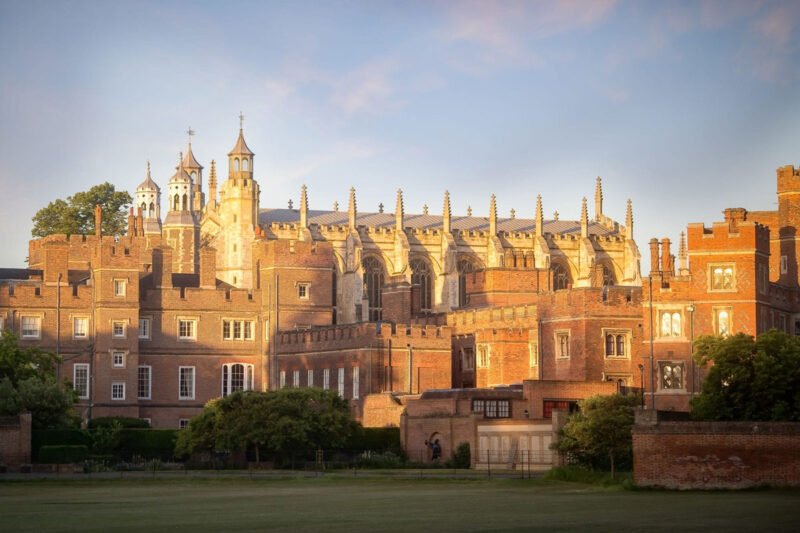Most people recognize Eton College as Britain’s most prestigious boarding school, but few know about its humble beginnings. The story starts in 1440 when a young king had a revolutionary idea about education. What began as “Kynges College of Our Lady” tells us something fascinating about how institutions can completely transform over time.
The Royal Foundation of Kynges College of Our Lady (1440)
King Henry VI was just 18 when he decided to create something unprecedented. On October 11, 1440, he signed the Foundation Charter establishing “Kynge’s College of Our Ladye of Eton besyde Windesore.” The official name was actually “Royal College of the Blessed Mary of Eton by Windsor” – quite a mouthful by today’s standards.
Henry chose this location deliberately. Born at nearby Windsor Castle, he wanted his educational experiment close to home. The charter did something clever: it converted Eton’s old parish church into both a place of worship and learning. This wasn’t unusual for the time, when education and religion went hand in hand.
There was method behind Henry’s timing too. Just one year later, he founded King’s College, Cambridge. His plan was simple but ambitious: students would start at Kynges College of Our Lady, then continue to Cambridge. It was medieval England’s first coordinated educational pathway.
A Charitable Vision for Educational Access
Here’s where the story gets interesting. Henry VI didn’t create Kynges College of Our Lady for rich kids. Quite the opposite, actually. He designed it as a charity school for 70 poor boys who couldn’t afford education elsewhere. These students became known as King’s Scholars, and everything was free – tuition, room, and board.
The Foundation Charter was crystal clear about this mission. It promised education “free of charge and without any pecuniary exaction.” But Henry went further. He also welcomed other students who could pay for accommodation while still receiving free teaching. These became the Oppidans, from the Latin word for “town.”
Henry wasn’t working in isolation. He studied Winchester College intensively, visiting at least six times between 1441 and 1452. He even poached Winchester’s headmaster, William Waynflete, to run his new school. Some scholars transferred from Winchester to help get things started. Henry was borrowing the best practices he could find.
The Institutional Structure and Daily Life
Medieval education was nothing like today’s schools. Kynges College of Our Lady housed an entire community: a Provost, ten priests, four clerks, six choristers, 25 poor scholars, 25 almsmen, plus teaching staff. Everyone lived together in what was essentially a religious-academic commune.
Daily life was strictly regimented. Students woke at 5 AM for prayers, started lessons at 6 AM, and didn’t finish until 8 PM. They got exactly one hour of free time each day. The statutes from around 1451 controlled everything – what they wore, what they ate, how they behaved.
Clothing rules were particularly strict. Students wore “long gowns of a simple and plain form” in solid colors only. No stripes, no patterns, nothing flashy. The message was clear: this was serious business, not a fashion show. These rules stayed in place for over 400 years, until reforms in 1871.
Educational Philosophy and Curriculum Design
Henry VI had big ambitions for his school. He wanted it to be the “mirror and mistress of all other grammar Schools.” To ensure this, he banned any other grammar school within ten miles of Windsor. Talk about eliminating competition.
The curriculum was laser-focused on Latin. That’s it – just Latin. Students as young as five learned Latin grammar all day, every day. Greek wasn’t added until the early 1600s. This might seem limited now, but Latin was the key to everything in medieval society – law, medicine, theology, administration.
What made the school special wasn’t just what it taught, but who it taught. The Foundation Charter emphasized that anyone could receive free instruction, regardless of background. This was radical thinking for 1440.
Historical Challenges and Transformations
Everything changed in 1461 when Henry VI lost his throne to Edward IV. The new king wasn’t interested in his predecessor’s educational experiments. He cancelled all grants to the school and seized most of its treasures for St George’s Chapel across the river.
This could have been the end of the story. Legend says Edward IV’s mistress, Jane Shore, intervened to save the school. Whether that’s true or not, something prevented complete destruction. The school survived, though much smaller and poorer than Henry had envisioned.
The grand chapel Henry planned was never finished. He’d wanted the longest nave in Europe, but construction stopped when he was deposed. Only the choir section got completed. The school limped along for decades before gradually rebuilding its fortunes.
Evolution from Charity to Elite Institution
The transformation didn’t happen overnight. For centuries, Kynges College of Our Lady remained relatively small and focused on its original mission. The first proper boarding house wasn’t built until 1722. By the 1760s, there were thirteen houses, mostly run by teachers.
The 19th century brought massive changes. The Clarendon Commission of 1861 forced major reforms in facilities, curriculum, and staffing. Mathematics was added in 1851 – the first new subject in over 400 years. By 1891, over a thousand boys were studying everything from science to modern languages in brand-new buildings.
The 20th century saw another shift. Family connections mattered less; academic ability mattered more. This was actually closer to Henry VI’s original vision, though the social context had completely changed. Since 2002, every student has had to earn their place through testing and interviews.
The Modern Legacy of Kynges College of Our Lady
Today’s Eton College would shock Henry VI. Annual fees exceed £50,000. The student body includes future prime ministers, tech billionaires, and Hollywood stars. It’s become synonymous with British elite education and political power.
Yet some connections to the original vision remain. King’s Scholars still live in College, maintaining that direct link to 1440. The school provides substantial financial aid to students who can’t afford full fees. About 20% of students receive some form of assistance.
The alumni list reads like a who’s who of British influence: 20 prime ministers, countless cabinet ministers, Nobel Prize winners, Oscar winners. This isn’t what Henry VI planned, but it’s certainly made the school famous worldwide.
Reflections on Educational Transformation
The journey from Kynges College of Our Lady to modern Eton College raises uncomfortable questions. How does a school founded explicitly for poor children become a symbol of privilege? What does this say about educational ideals versus social reality?
Part of the answer lies in broader social changes. Medieval concepts of royal charity gave way to market-driven education. What started as noblesse oblige became commercial enterprise. The school adapted to survive, but lost much of its original character in the process.
Still, some of Henry VI’s vision persists. The emphasis on academic excellence remains. The idea of creating educational pathways to university continues. The integration of intellectual and character development survives. These aren’t small things.
The story of Kynges College of Our Lady reminds us that institutions are living things. They reflect the societies that create and sustain them. Understanding this history helps us think more clearly about education today – what we value, what we’re willing to pay for, and who gets access to the best opportunities.
Perhaps most importantly, it shows us that change is always possible. If a charity school for poor medieval boys could become the world’s most famous boarding school, what other transformations might we imagine for education in our own time?









